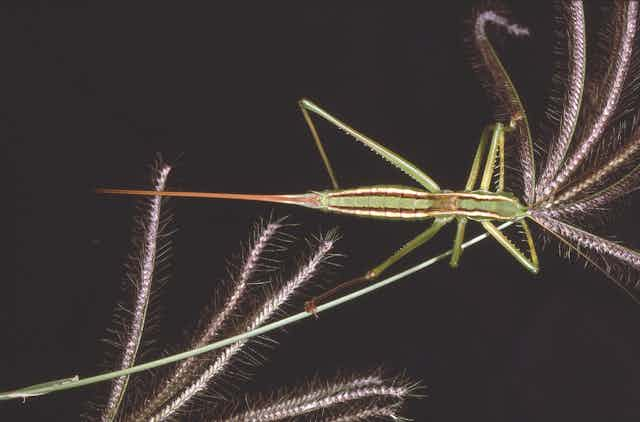Consider the katydids. Katydids are related to grasshoppers and crickets. They are generally long-legged, have long antennae and are nocturnal. The majority are herbivores but some are carnivorous. Several are highly specialised in their feeding habits such as pollen, nectar or flower feeders. Some are so abundant that they are important food for other insects and vertebrates. A few cause noticeable damage to native and introduced plants. There are about 1000 species in the Australian fauna with many still undescribed.
Territory Imitator (Alinjarria elongata) The Territory Imitator was described in 1993 from a single specimen held in the “undetermined section” of the Australian National Insect Collection (ANIC). This was a female collected in 1955 from Mataranka in the Northern Territory.
Vasse Pachysaga (Pachysaga strobila) The large, cumbersome Vasse Pachysaga is a member of the subfamily Austrosaginae. This is a relatively large component of the katydid fauna of Australia, mostly confined to the southern half of the continent in heath or mixed woodland. Found near Vasse in Western Australia, it is one of many species confined to the Southwest Australia biodiversity hotspot, an area of unique vegetation that harbours many unique and geographically restricted insects.
P. strobila is the most unusual of its genus in that it lacks a hind wing. All other Pachysaga species have either a distinctive red, yellow or grey hind wing. But there is none in the Vasse Pachysaga.
Shield-backed Katydids (Ixalodectes and Nanodectes) The five species of Ixalodectes and nine species of Nanodectes (9 species) belong to the subfamily of Shield-back Katydids. This subfamily is found mostly in the southern part of Australia and like many Australian species has links to Gondwana.
Both genera have species that are small and flightless. The wings of the males are reduced to small sound-producing instruments and the wings of the females are minute.
These katydids are mainly carnivorous, feeding on a variety of small insects. Most species in these genera are known for having very restricted distributions.
Beverley Shield-back (Ixalodectes flectocercus) The Beverley Shield-back was discovered in a series of unstudied shield-backs collected in Beverley, Western Australia in 1896, and held in the South Australian Museum. Like the Vasse Pachysaga it is an example of an insect restricted to the Southwest Australia hotspot.
Darke Peak Small Shield-back (Nanodectes bulbicercus) The Darke Peak Small Shield-back was found under circumstances similar to I. flectocercus. It lives in isolated patches of natural vegetation around the base of Darke Peak on the Eyre Peninsula in South Australia.

Status
These species made the IUCN list after they appeared in a monograph published by myself. Other species of grasshoppers and katydids are probably candidates for listing but there are few people in Australia concerned with these insects.
Territory Imitator As more individuals of this species have been found it appears that the species is rather widespread and probably not in danger. Perhaps it is time to remove this species from the IUCN Red List.
Vasse Pachysaga The Vasse Pachysaga is known only from its type specimen. Several attempts have been made to locate more, but to no avail. There are patches of natural vegetation near the coast that are worth investigating.
Beverley Shield-back This species was also known only from its type specimen until more were found in 1991 at Beverley in Western Australia.
Darke Peak Small Shield-back The type locality for this species is a disused quarry on the lower slopes of the mountain, surrounded by seas of wheat. Whether it is found on Darke Peake itself nobody knows. It is likely that no one has attempted to find this species since it was originally described in 1985. With pressures from agriculture, road building and mining, this species is probably threatened.
Threats
Vasse Pachysaga The immediate area around Vasse has been devastated by agricultural activities. Roadside verges, often the last vestiges of the local flora and fauna, are burned each year causing changes that promote introduced grasses and a variety of introduced plants such as Gladiolus. Little is left of natural vegetation.
Beverley Shield-back Most of the region near Beverley has been cleared for agriculture, mainly for wheat. The species was rediscovered in a tiny patch of natural vegetation surrounded by wheat fields. So far as known, this is the only place where the Beverley Shield-backed katydid can be found. A prescribed burn at the wrong season could spell its demise.
Darke Peak Small Shield-back The flora and fauna of Darke Peak and beyond are under threat from agriculture and certain practises such as spraying for pests.

Strategy
There is presently no recovery plan for these or other katydid species threatened by habitat destruction. With the depredations of the mining industry and the threat of state governments to open up land to farming, dams and other destructive activities, it may be time for additional research and survey work to be done. But with the demise of taxonomic study in Australian university curricula, expertise is diminishing as us “older” taxonomist leave the scene. There are no other Australians with a broad interest in the taxonomy, systematics and biology of katydids at present.
Conclusion
The history of the Territory Imitator and its rediscovery shows haphazard nature of katydid research. First collected by a colleague looking for other insects, it sat in the unidentified section of ANIC for 37 years until I recognised it and incorporated it into my monograph. This led to further exploration and discoveries of the species elsewhere. Present-day collectors are often very parochial about the things they collect and many never collect anything outside their speciality. What a pity it would have been if this specimen had not been collected in 1955.
The Conversation is running a series on Australian endangered species. See it here.

